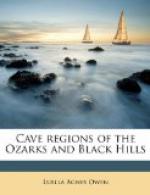Continuing the subject, Professor Todd says: “Accepting this explanation of the striking red color, the question remains as to how these circumstances, favorable for its formation, were produced.
“This red color is quite common in the whole Rocky Mountain region, not only on the eastern slope of the mountains, but to the various detached members of the system. We must, therefore, look for some extensive condition. If we seek some case in the present, parallel to the one already indicated, we perhaps can find none better than one on the eastern shore of the Caspian Sea, where, because of dry climate and the shallow waters, the deposition of gypsum and salt is now going on. In the gulf known as the Kara Boghaz, which is separated from the Caspian by a narrow strait, the evaporation is so rapid as to produce an almost constant flow from the sea into it. This strait and this gulf give the impression to an unlearned observer that there must be a mysterious subterranean outlet. The water flows in, carrying with it the salt and other soluble minerals. It then evaporates, leaving the salt and minerals behind.”
This explanation is calculated to afford particular pleasure to the many visitors to the Garden of the Gods, in Colorado, who seldom receive satisfactory answers to their questions as to the reasons “why.” In that much visited spot, however, the great mass of the deposit has been removed by erosion and the curiously shaped remnants are only such portions as were exceptionally hard and consequently withstood the action of the submerging waters.
Having made a considerable stop on the way to Wind Cave, we will now hurry on, but with good horses and a fine day the drive is one of great pleasure. The road gradually rises to higher ground and soon reaches a point six hundred feet more elevated than Hot Springs, with a charming view of hill and valley distances, and the way then continues over the hill-tops. At one point by the roadside a circle of tent-stones still marks the spot occupied by Sitting Bull for a week or more after the Custer massacre, while he camped here and in the security of his commanding position watched the movements of the government troops who were in search of him.
Hot Springs and Buffalo Gap are both included in the wide-spread view. Beside the road and scattered about in all directions are fine specimens of agates and quartz crystal which seem most beautiful and most abundant on the hills in the immediate vicinity of the cave, the crystals being either rose pink, pale green, yellow, white or colorless.
Arriving at the cave, the entrance is not visible, but between the ravine in which it is located and the road, there is the cave office and small hotel, on the ravine side of which an outer stairway leads down to the cave entrance, over which has been built a log cabin.
On account of the precautions taken for the protection of visitors, accidents are so rare that it might almost be said that none occur. Every person is required to register before entering the cave and all returning parties are carefully counted, although they are usually unaware of the fact. They are always accompanied by two guides and others are added if the party is large. No one is, on any account, permitted to wander in advance of the head guide or linger behind the one in the rear.




